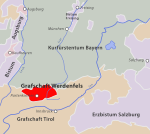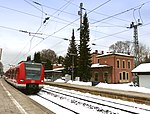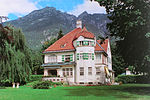Werdenfels Castle
Buildings and structures in Garmisch-Partenkirchen (district)Heritage sites in BavariaHill castles

The ruins of Werdenfels Castle (German: Burg Werdenfels) stand about 80 metres above the Loisach valley between Garmisch and Farchant in the county of Garmisch-Partenkirchen in Upper Bavaria. The spur castle was used until 1632 as the administrative centre of the County of Werdenfels, but began to fall into disrepair thereafter. The castle ruins are freely accessible and are a popular hiking destination with a good view of Garmisch-Partenkirchen and the Wetterstein Mountains.
Excerpt from the Wikipedia article Werdenfels Castle (License: CC BY-SA 3.0, Authors, Images).Werdenfels Castle
Schwaigwang,
Geographical coordinates (GPS) Address External links Nearby Places Show on map
Geographical coordinates (GPS)
| Latitude | Longitude |
|---|---|
| N 47.516458 ° | E 11.0919 ° |
Address
Burgruine Werdenfels
Schwaigwang
82467 , Burgrain
Bavaria, Germany
Open on Google Maps









